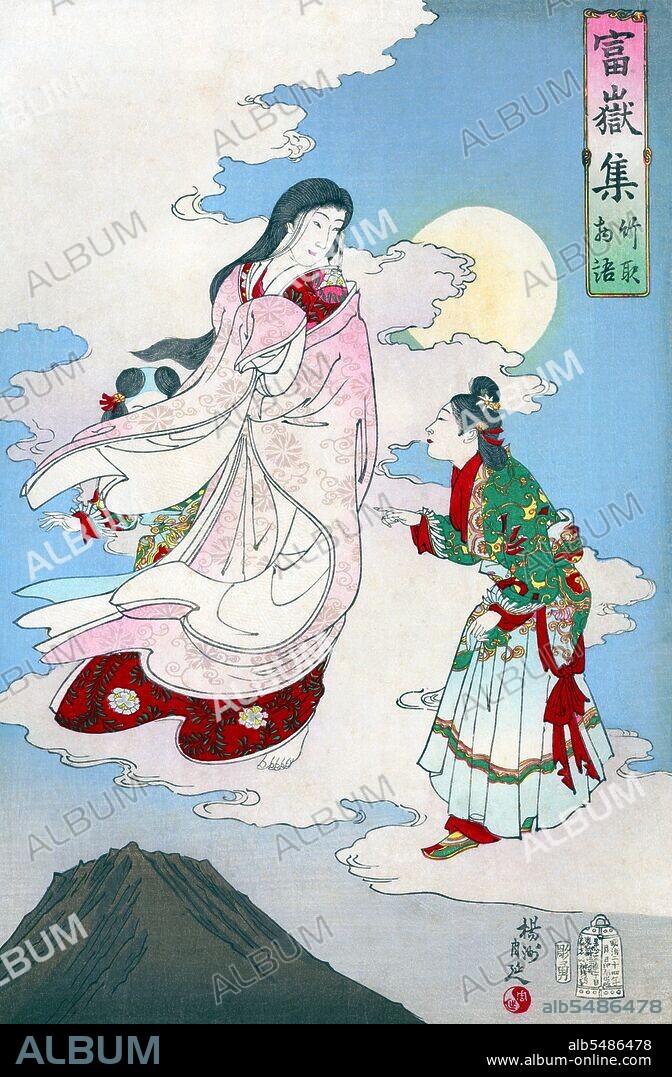alb5486478
Japan: Kaguya-hime, immortal moon maiden. Ukiyo-e woodblock print by (Toyohara) Yoshu Chikanobu (1838-1912)

|
Añadir a otro lightbox |
|
Añadir a otro lightbox |



¿Ya tienes cuenta? Iniciar sesión
¿No tienes cuenta? Regístrate
Compra esta imagen.
Selecciona el uso:

Título:
Japan: Kaguya-hime, immortal moon maiden. Ukiyo-e woodblock print by (Toyohara) Yoshu Chikanobu (1838-1912)
Descripción:
Traducción automática: Este triste cuento de hadas, la narrativa japonesa más antigua conocida, se remonta al siglo IX o X. En este cuento, Kaguya-hime fue encontrada dentro de un tallo de bambú por un cortador de bambú, quien la llevó a casa y la crió como a su hija (1891). Toyohara Chikanobu (????) (1838-1912), más conocido por sus contemporáneos como Yoshu Chikanobu (????), fue un prolífico artista de xilografías del período Meiji de Japón. Sus obras capturan la transición de la era de los samuráis a la modernidad Meiji. En 1875 (Meiji 8), decidió intentar ganarse la vida como artista. Viajó a Tokio. Encontró trabajo como artista para el Kaishin Shimbun. Además, produjo obras de arte nishiki-e. En su juventud, había estudiado en la escuela de pintura de Kano; pero su interés se centró en ukiyo-e. Como muchos artistas de ukiyo-e, Chikanobu dirigió su atención hacia una gran variedad de temas. Su trabajo abarcó desde la mitología japonesa hasta representaciones de los campos de batalla de su vida y la moda femenina. Al igual que otros artistas de este período, también interpretó personajes de actores de kabuki y es conocido por sus impresiones de la mie (pose formal) de las producciones de kabuki. Chikanobu era conocida como una maestra de la bijinga, imágenes de mujeres hermosas, y por ilustrar los cambios en la moda femenina, incluida la vestimenta tradicional y occidental. Su trabajo ilustró los cambios en los peinados y el maquillaje a lo largo del tiempo. Por ejemplo, en las imágenes de Chikanobu en Mirror of Ages (1897), los peinados de la era Tenmei, 1781-1789, se distinguen de los de la era Keio, 1865-1867.
The oldest known Japanese narrative, this sad fairy tale dates back to the 9th or 10th century. In this tale Kaguya-hime was found inside a bamboo stalk by a bamboo cutter, who took her home and raised her as his daughter (1891). Toyohara Chikanobu (????) (1838–1912), better known to his contemporaries as Yoshu Chikanobu (????), was a prolific woodblock artist of Japan's Meiji period. His works capture the transition from the age of the samurai to Meiji modernity. In 1875 (Meiji 8), he decided to try to make a living as an artist. He travelled to Tokyo. He found work as an artist for the Kaishin Shimbun. In addition, he produced nishiki-e artworks. In his younger days, he had studied the Kano school of painting; but his interest was drawn to ukiyo-e. Like many ukiyo-e artists, Chikanobu turned his attention towards a great variety of subjects. His work ranged from Japanese mythology to depictions of the battlefields of his lifetime to women's fashions. As well as a number of the other artists of this period, he too portrayed kabuki actors in character, and is well-known for his impressions of the mie (formal pose) of kabuki productions. Chikanobu was known as a master of bijinga, images of beautiful women, and for illustrating changes in women's fashion, including both traditional and Western clothing. His work illustrated the changes in coiffures and make-up across time. For example, in Chikanobu's images in Mirror of Ages (1897), the hair styles of the Tenmei era, 1781-1789 are distinguished from those of the Keio era, 1865-1867.
Crédito:
Album / Pictures From History/Universal Images Group
Autorizaciones:
Tamaño imagen:
3349 x 5100 px | 48.9 MB
Tamaño impresión:
28.4 x 43.2 cm | 11.2 x 17.0 in (300 dpi)
Palabras clave:
ART • ARTE • ARTES • ASIA • ASIATICO • CUENTO DE HADAS • CUENTO • GRABADO EN MADERA • HISTORIA • HISTORICO • JAPON • JAPONES • MITO • MITOS • MUJER • MUJERES • PINTURA • PLANCHA DE MADERA • SOBRENATURAL • UKIYO-E • XILOGRAFIA
 Pinterest
Pinterest Twitter
Twitter Facebook
Facebook Copiar enlace
Copiar enlace Email
Email
